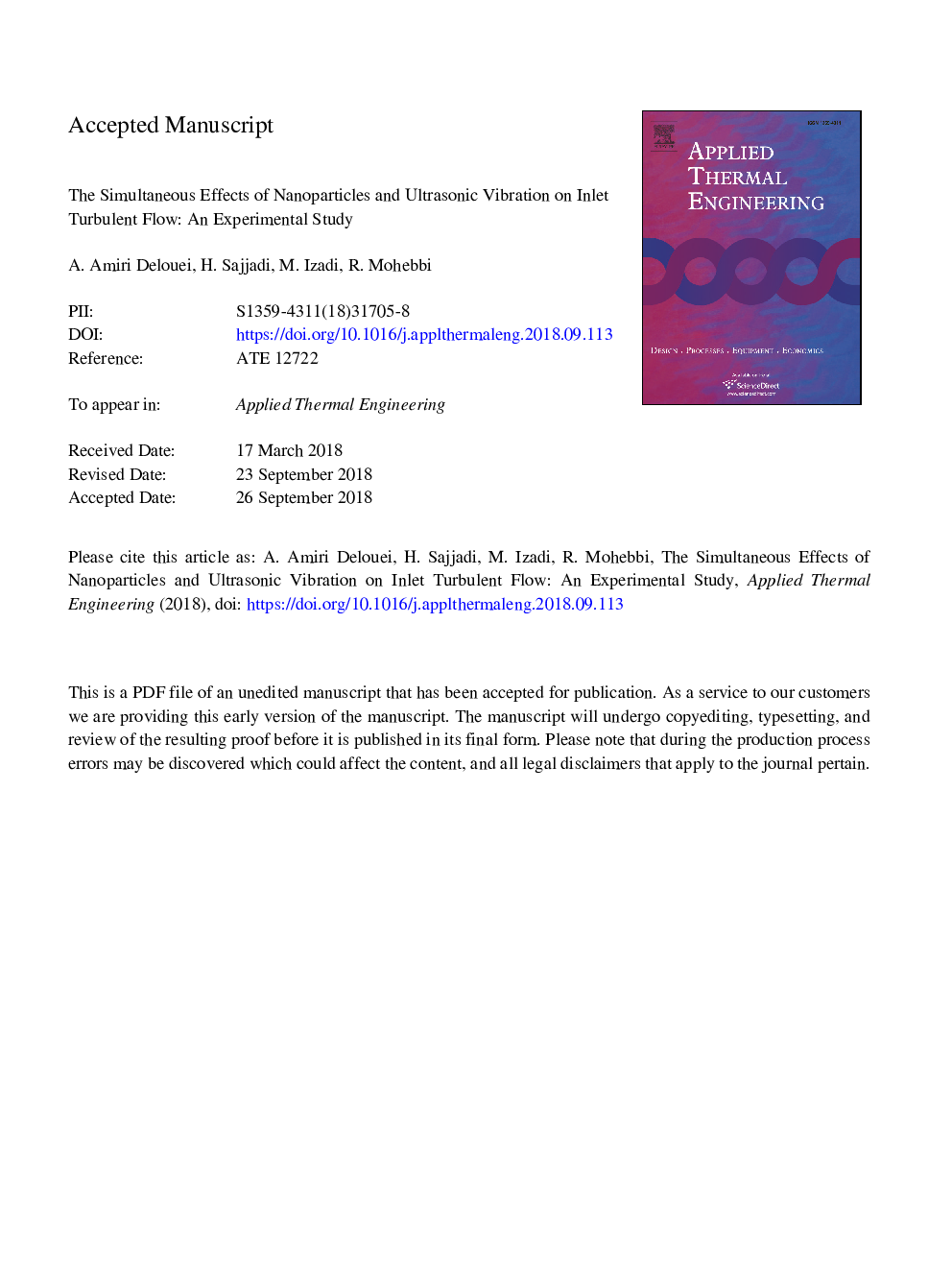| کد مقاله | کد نشریه | سال انتشار | مقاله انگلیسی | نسخه تمام متن |
|---|---|---|---|---|
| 11020822 | 1715612 | 2019 | 37 صفحه PDF | دانلود رایگان |
عنوان انگلیسی مقاله ISI
The simultaneous effects of nanoparticles and ultrasonic vibration on inlet turbulent flow: An experimental study
ترجمه فارسی عنوان
اثرات همزمان نانوذرات و ارتعاش اولتراسونیک در جریان آشفته جریان ورودی: یک مطالعه تجربی
دانلود مقاله + سفارش ترجمه
دانلود مقاله ISI انگلیسی
رایگان برای ایرانیان
کلمات کلیدی
مطالعه تجربی، نانو سیال، ارتعاشات التراسونیک، افزایش انتقال حرارت، جریان آشفته
ترجمه چکیده
در مطالعه حاضر اثرات ارتعاشات اولتراسونیک و نانوذرات بر کاهش افت فشار و افزایش انتقال حرارت جریان ورودی جریان تجربی بررسی شده است. دو عامل مهم در طراحی مبدلهای حرارتی، به عنوان مثال، بهبود انتقال حرارت و افت فشار، در بخش های مختلف نانو ذرات، سطح قدرت اولتراسونیک و سرعت جریان در نظر گرفته شده است. همبستگی های تجربی موجود برای اطمینان از صحت ابزار اندازه گیری استفاده می شود. مشاهده می شود که اثر ارتعاشات سونوگرافی بر روی تعداد رینولدز پایین تر و همچنین درصد نانو ذرات بیشتر دیده می شود. نتایج نشان می دهد که ارتعاشات اولتراسونیک می تواند منفی اثر افت فشار را کاهش دهد و اثر مثبت افزایش انتقال حرارت ناشی از نانوذرات را به ترتیب به 15.27٪ و 11.37٪ افزایش دهد. اثر تغییرات سطح قدرت اولتراسونیک نیز در نانوسیالهای با غلظت بیشتر و سرعت جریان کمتر است. نتایج این کار برای طراحی مبدل های حرارتی ارتعاشی آینده که همچنین توانایی کار با نانوفیلد را دارند، مفید خواهد بود.
موضوعات مرتبط
مهندسی و علوم پایه
مهندسی شیمی
جریان سیال و فرایندهای انتقال
چکیده انگلیسی
In the current study, the effects of the ultrasonic vibration and nanoparticles on the pressure drop and heat transfer enhancement of inlet turbulent flow are experimentally investigated. Two important factors in the design of heat exchangers, namely, heat transfer improvement and pressure drop, have been considered at different nanoparticle volume fractions, ultrasonic power levels, and flow rates. Existing experiential correlations are utilized to ensure the accuracy of the measurement instruments. It is observed that the effects of ultrasound vibration are more pronounced on the lower Reynolds number as well as the higher nanoparticle volume fraction. The result indicates that the ultrasonic vibrations could reduce the negative effect of pressure drop and improve the positive effect of heat transfer enhancement caused by nanoparticles up to 15.27% and 11.37%, respectively. The effect of ultrasonic power level variation is also bolder in more concentrated nanofluids and lower flow rates. The results of this work will be useful for designing future-oriented vibrating heat exchangers that also have the ability to work with nanofluid.
ناشر
Database: Elsevier - ScienceDirect (ساینس دایرکت)
Journal: Applied Thermal Engineering - Volume 146, 5 January 2019, Pages 268-277
Journal: Applied Thermal Engineering - Volume 146, 5 January 2019, Pages 268-277
نویسندگان
A. Amiri Delouei, H. Sajjadi, M. Izadi, R. Mohebbi,
